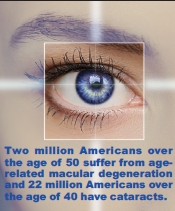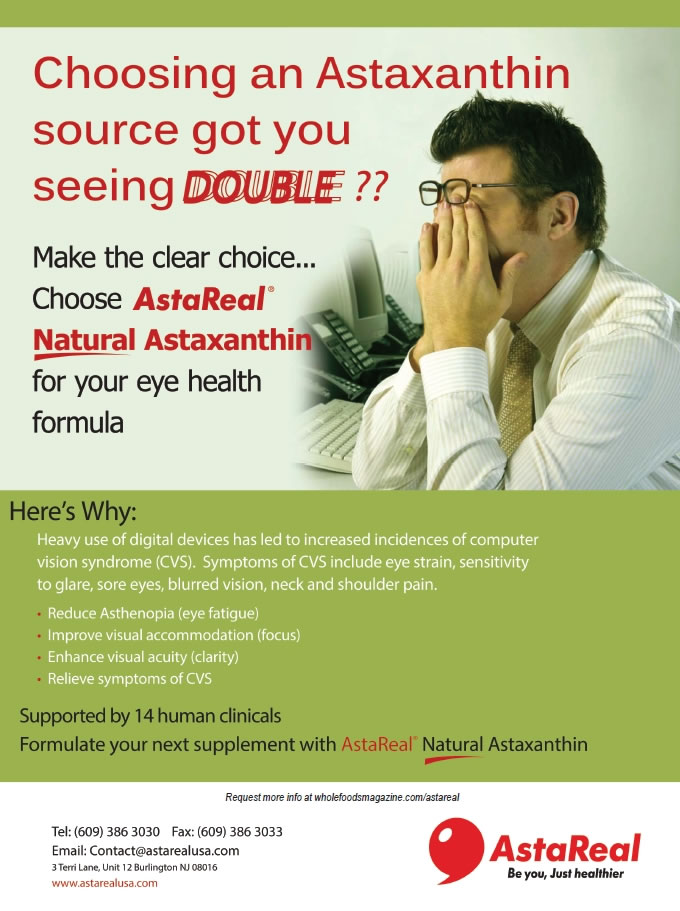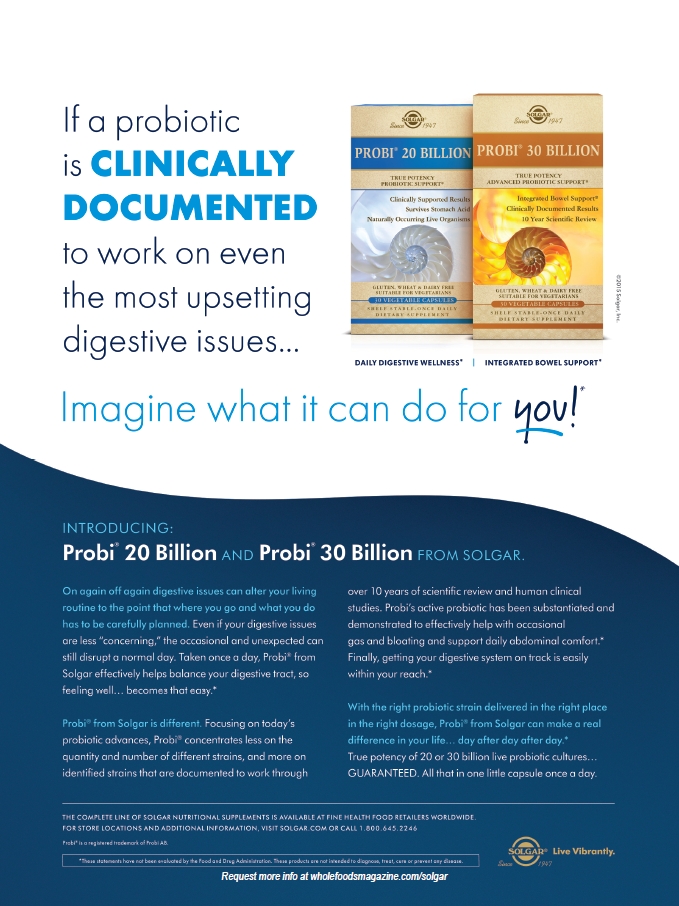While many of us turn to supplements to improve our quality of life, there are some facets of health that are often missed. One frequently overlooked category is eye health.
Like any other part of the body, the eyes have specific health needs and conditions can arise if they are not met. Two million Americans over the age of 50 suffer from age-related macular degeneration (ARMD), a leading cause of blindness in older adults (1). In addition, 22 million Americans over the age of 40 have cataracts (2). Dietary supplements will not cure or prevent these diseases, however, some can contribute to overall eye health and may even support overall vision down the road.
not met. Two million Americans over the age of 50 suffer from age-related macular degeneration (ARMD), a leading cause of blindness in older adults (1). In addition, 22 million Americans over the age of 40 have cataracts (2). Dietary supplements will not cure or prevent these diseases, however, some can contribute to overall eye health and may even support overall vision down the road.
What Is AREDS?
Part of what we know about dietary supplements and eye health comes from the Age Related Eye Disease Study (AREDS), sponsored by the National Eye Institute. Originally launched in 1992, this study was designed to determine if the daily intake of certain vitamins and minerals could reduce the risk of advanced ARMD and cataracts. In the initial five-year trial period, participants were either given the AREDS formulation—a combination of vitamins E and C, beta-carotene and zinc—or a placebo. These particular vitamins were selected because of their strong antioxidant content, which some people may be lacking in their diets. At the end of the trial period, all participants were given the option of taking the AREDS formulation for a five-year follow up study.
 At the conclusion of the 10-year period, participants who had been assigned to the AREDS formulation in the original trial were 25–30% less likely to develop advanced ARMD than the placebo group. In a group of participants previously determined to be at highest risk for ARMD, 34% who had taken the AREDS formulation in the trial progressed to advanced ARMD, compared with 44% in the placebo group. While the formula showed no substantial effects on cataracts or in patients with no or early ARMD, the researchers concluded that the formulation could be effective for slowing the progressions of ARMD, especially for high-risk patients (3).
At the conclusion of the 10-year period, participants who had been assigned to the AREDS formulation in the original trial were 25–30% less likely to develop advanced ARMD than the placebo group. In a group of participants previously determined to be at highest risk for ARMD, 34% who had taken the AREDS formulation in the trial progressed to advanced ARMD, compared with 44% in the placebo group. While the formula showed no substantial effects on cataracts or in patients with no or early ARMD, the researchers concluded that the formulation could be effective for slowing the progressions of ARMD, especially for high-risk patients (3).
New Additions
While antioxidant vitamins and zinc have been the prime supplement choices for eye health for quite some time, other nutrients have emerged as possibilities. Carotenoids are a family of pigments typically found in leafy vegetables and colored fruits. Some of them have already found their way to the dietary supplements market, like lycopene offering prostate support. While beta-carotene was already in the initial AREDS formation, more recent research shows that two carotenoids in particular, lutein and zeaxanthin, may have some applications for eye health, as they are the only carotenoids present in the retina, where they may be able to protect against light-induced oxidative damage by absorbing blue light. Light-induced oxidative damage is thought to be an underlying cause of ARMD.
In one study, 70 patients exhibiting early signs of ARMD were randomly assigned to take either 10 mg of lutein or a placebo daily over the course of one year. Blood samples were taken at baseline, as well as the four-, eight-, and 12-month marks. Study results showed that the lutein group experienced an overall 1.1 ng/ml monthly decrease in plasma sC5b-9 concentration, while concentration levels increased overall in the placebo group. The research scientists believe these results demonstrated that lutein could inhibit systemic activation of the complement system (a potential cause of ARMD), and that these results provided further evidence that lutein could help manage the condition (4).
Meanwhile, another carotenoid, astaxanthin is said to support eye health in several ways. The nutrient is said to “increase blood flow to the retina, further protecting the eyes,” according to physician William Sears, M.D. (5). He says this is especially helpful for eye fatigue and strain. Those taking 5 mg of astaxanthin per day in one month-long study experienced a 46% reduction in eye strain (5).
Another supplement with possible eye health benefits has also been looked at for many other uses: omega-3s. DHA is a major component of the photoreceptor of the retina, and it is known that deficiencies of it increase with age, which is when eye health issues like ARMD and others develop. In  one study, 74 healthy participants were given either 1,000 mg of a tuna oil supplement providing 252 mg DHA, 60 mg EPA and 10 mg vitamin E, or a placebo daily over a 90-day period. The study results showed a significant increase in right eye acuity in the omega group over placebo, something that the researchers noted lent support to previous research with similar positive results (6).
one study, 74 healthy participants were given either 1,000 mg of a tuna oil supplement providing 252 mg DHA, 60 mg EPA and 10 mg vitamin E, or a placebo daily over a 90-day period. The study results showed a significant increase in right eye acuity in the omega group over placebo, something that the researchers noted lent support to previous research with similar positive results (6).
AREDS 2
Due to the mounting scientific evidence for new supplements for eye health, a second AREDS was launched in 2006, designed to see if omega-3s, lutein, and zeaxanthin could also slow the development of advanced ARMD when added to the original AREDS formulations. Four groups were covered: a control group taking the original formulation, one with lutein and zeaxanthin added, one with EPA and DHA added and another with both additions. This study took place over the course of five years, with results determined by retinal photographs.
While some of the results were positive, others yielded some surprises. Participants with low levels of
who then took a formulation containing it were 25% less likely to develop advanced ARMD than those who did not. Interestingly, participants who took an AREDS formulation with lutein and zeaxanthin but no beta-carotene also saw a positive result, being 18% less likely to develop advanced ARMD. The researchers stated that it may be possible that carotenoids would compete against each other for absorption, hence the results, but they also noted that those who took lutein and zeaxanthin along with beta-carotene still had some level of reduced risk (7).
With regard to cataracts, only those with the lowest level of dietary intake of lutein and zeaxanthin saw any effect, with a 32% reduction in progression to cataract surgery. DHA and EPA did not show any substantial effect in either category, though the researchers remarked that they were shown to promote retinal development and repairs in previous studies (3). WF
|
Dry Eyes No More? Omega-3s are one of the most versatile supplements around, so it’s no surprise that there may be multiple applications for them with regard to eye health as well. In addition to possibly helping with eye diseases such as age-related macular degeneration, it is believed that omega-3 supplementation may help with dry eye syndrome. Occurring when the eye is either unable to produce tears or produces tears that are not the proper consistency, dry eye syndrome can lead to inflammation of the eye, and if untreated, ulcers or scars on the cornea and even some loss of vision may occur (1). In one study, 264 patients either took a 500-mg capsule containing 325 mg of EPA and 175 mg of DHA twice daily over the course of three months or a placebo. At the conclusion of the study, while both groups experienced improvement with dry eye symptoms, 65% of the omegas group showed significant improvement compared to 33% of the placebo group. While the researchers ultimately concluded that more research would be needed, they acknowledged that “omega-3 fatty acids have a definite role for dry eye syndrome.” Some potential reasons behind this, they hypothesized are the ability of omega-3s to modulate inflammation in the body, as well as altering lipid profiles in meibomian glands, improving tear composition (3). |
References
1. Linus Pauling Institute, “Carotenoids,” http://lpi.oregonstate.edu/infocenter/phytochemicals/carotenoids, accessed Apr. 3, 2015.
2. New York State Department of Health, “Data and Statistics,” https://www.health.ny.gov/diseases/conditions/vision_and_eye_health/data_and_statistics.htm, accessed Apr. 1, 2015.
3. National Eye Institute, “Questions and Answers about AREDS 2,” www.nei.nih.gov/areds2/MediaQandA, accessed Apr. 7, 2015.
4. Y. Tian et al., “Lutein Supplementation Leads to Decreased Soluble Complement Membrane Attack Complex sC5b-9 Plasma Levels,” Acta Ophthalmologica, 93 (2), 141–145 (2015).
5. W. Sears, Natural Astaxanthin: Hawaii’s Supernutrient, 2nd Ed. (William Sears, MD, 2015).
6. C. Stough et al., “The Effects Of 90-Day Supplementation With The Omega-3 Essential Fatty Acid
Docosahexaenoic Acid (DHA) On Cognitive Function And Visual Acuity In A Healthy Aging Population,” Neurobiology of Aging, 33 (4), 824.e1–824.e3 (2012).
7. WholeFoods Magazine, “Lutein and Zeaxanthin May Reduce Progression of Age-Related Macular Degeneration,” www.wholefoodsmagazine.com/news/breaking-news/lutein-and-zeaxanthin-may-reduce-progression-age-related-macular-degeneration45687789123, accessed Apr. 7, 2015.
Published in WholeFoods Magazine, June 2015


 Though the notion of a possible relationship omega-3 deficiency and dry eye syndrome is relatively new, recent scientific results are proving to be a cause for attention. One study in the American Journal of Nutrition compiled food frequency questionnaire data from over 32,000 women ages 46-84 used for the Women’s Health Study, and discovered some interesting facts. According to the investigators, women with a higher intake of omega-3 fatty acids had less incidents of dry eye syndrome from those who did not (2). Clinical trials have also been taken to determine any possible correlation.
Though the notion of a possible relationship omega-3 deficiency and dry eye syndrome is relatively new, recent scientific results are proving to be a cause for attention. One study in the American Journal of Nutrition compiled food frequency questionnaire data from over 32,000 women ages 46-84 used for the Women’s Health Study, and discovered some interesting facts. According to the investigators, women with a higher intake of omega-3 fatty acids had less incidents of dry eye syndrome from those who did not (2). Clinical trials have also been taken to determine any possible correlation.








